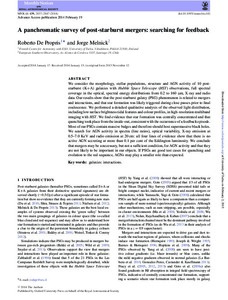A panchromatic survey of post-starburst mergers: searching for feedback
De Propris R; Melnick J
https://urn.fi/URN:NBN:fi-fe2021042715088
Tiivistelmä
We consider the morphology, stellar populations, structure and AGN activity of 10 post-starburst (K+A) galaxies with Hubble Space Telescope (HST) observations, full spectral coverage in the optical, spectral energy distributions from 0.2 to 160 mu m, X-ray and radio data. Our results show that the post-starburst galaxy (PSG) phenomenon is related to mergers and interactions, and that star formation was likely triggered during close passes prior to final coalescence. We performed a detailed qualitative analysis of the observed light distribution, including low surface brightness tidal features and colour profiles, in high-resolution multiband imaging with HST. We find evidence that star formation was centrally concentrated and that quenching took place from the inside-out, consistent with the occurrence of a feedback episode. Most of our PSGs contain massive bulges and therefore should host supermassive black holes. We search for AGN activity in spectra (line ratios), optical variability, X-ray emission at 0.5-7.0 KeV and radio emission at 20 cm: all four lines of evidence show that there is no active AGN accreting at more than 0.1 per cent of the Eddington luminosity. We conclude that mergers may be a necessary, but not a sufficient condition, for AGN activity and that they are not likely to be important in our objects. If PSGs are good test cases for quenching and evolution to the red sequence, AGNs may play a smaller role than expected.
Kokoelmat
- Rinnakkaistallenteet [19207]
